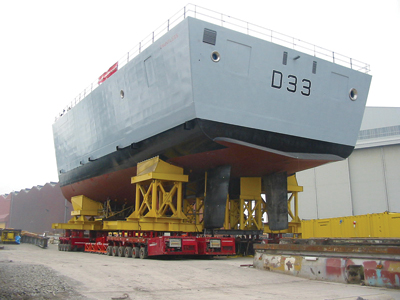



 |
   |
Weighing and Manipulation System for Ship's Hull Sections 
Irene Kremer, Enerpac BV,
Enerpac's PLC-controlled synchronous lifting system ensures that the desired load paths into the ship's hull structure are maintained during transport. Six Daring Class Type 45 anti-air warfare destroyers are being assembled, launched and outfitted for the UK Royal Navy at BAE Systems Surface Fleet Solutions' Govan & Scotstoun shipyards in Glasgow. The bow sections, masts and funnels for all six ships are being built in Portsmouth. These destroyers will have an overall length of 152.4 m, space for a crew of 235, a displacement of 7350 t, a top speed greater than 27 kt and its range greater than 7000 NM. The first one is HMS Daring and is to enter service in May 2009. The ship's hull is manufactured in sections or "blocks" in a fabrication shop adjacent to the berth and slipway. Five blocks are moved in total to build one ship of which the heaviest block weighs over 1400 t.
The Enerpac Synchronous Lifting System is now used to lift the block free from the transport so that they can be driven away. During the lifting procedure the 16 points PLC-controlled synchronous lifting system operates within strict load and stroke constraints to ensure that the desired load paths into the ship's hull structure are maintained. With the transport removed and the hull segments supported by the hydraulic system, the blocks are weighed with the synchronous lifting system to confirm the design calculations. Slide-track installation, lowering and block manipulation
Hydraulic System Integration The Type 45's weight must be optimised and consequently the hull skin is relatively thin when compared with a commercial ship. Therefore when lifting and lowering, the load paths must be strictly controlled and this would be almost impossible with manually controlled systems. Controlled hydraulic movement brings safety to the structure. The second advantage is the increase of productivity where hundreds of man hours were saved against traditionally controlled lifting methods. Moreover, this versatile lifting system is employed on various other lifting and weighing operations around the shipyard. Enerpac hydraulic system integration, of high force hydraulics and advanced control technology, nowadays play an important role in the controlled movement of large-scale engineering projects, like the launching of the French Millau Viaduct, and lifting and weighing of these heavy ship's hull segments.
|
|
© InfraStructures - Tous droits réservés - All rights reserved |